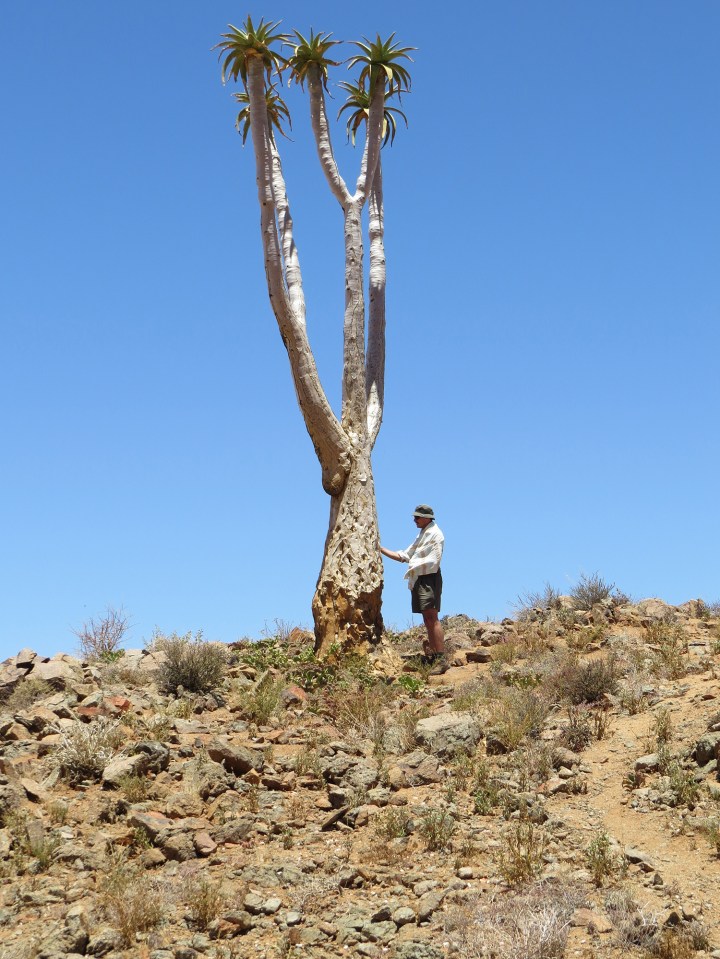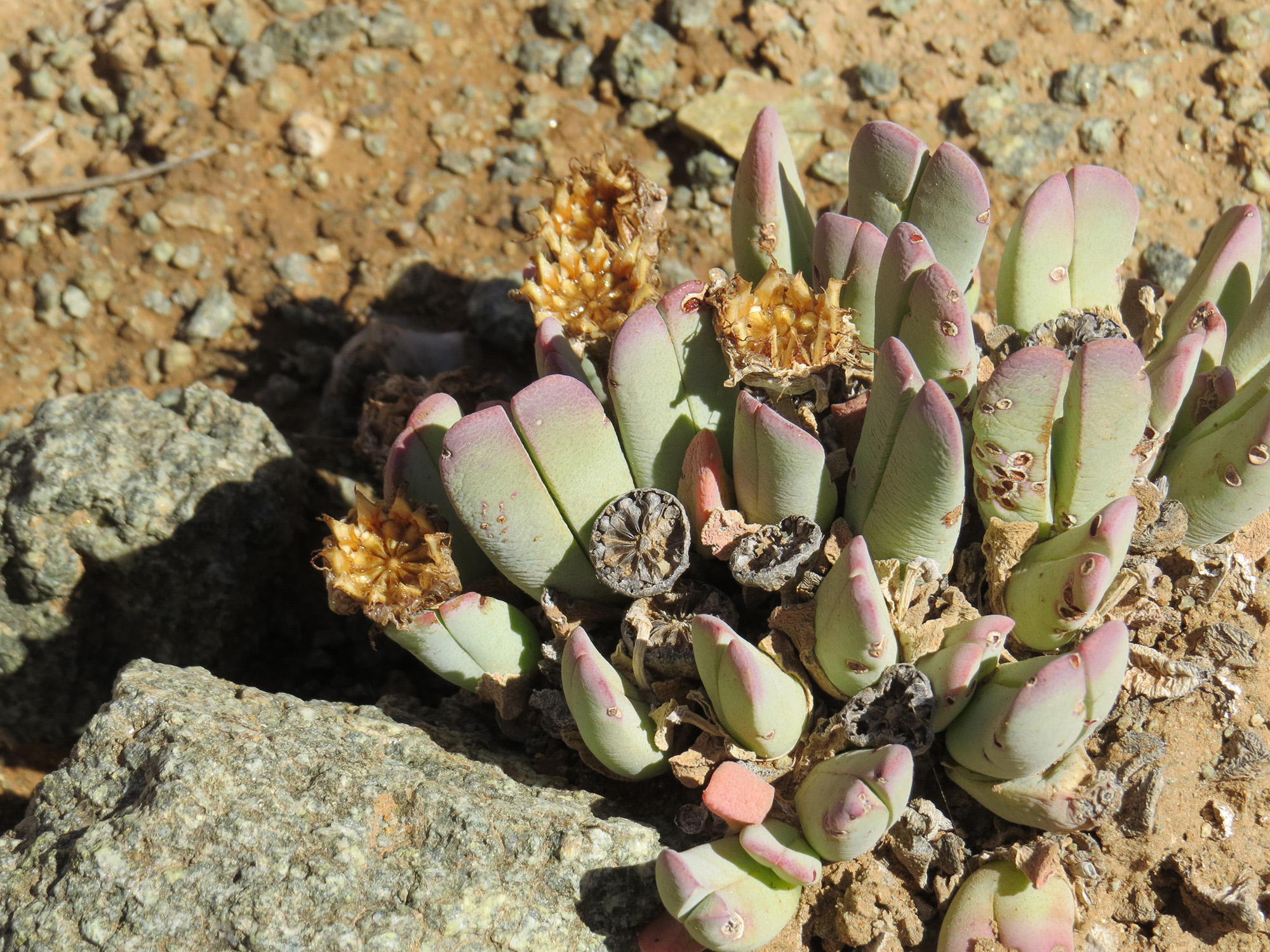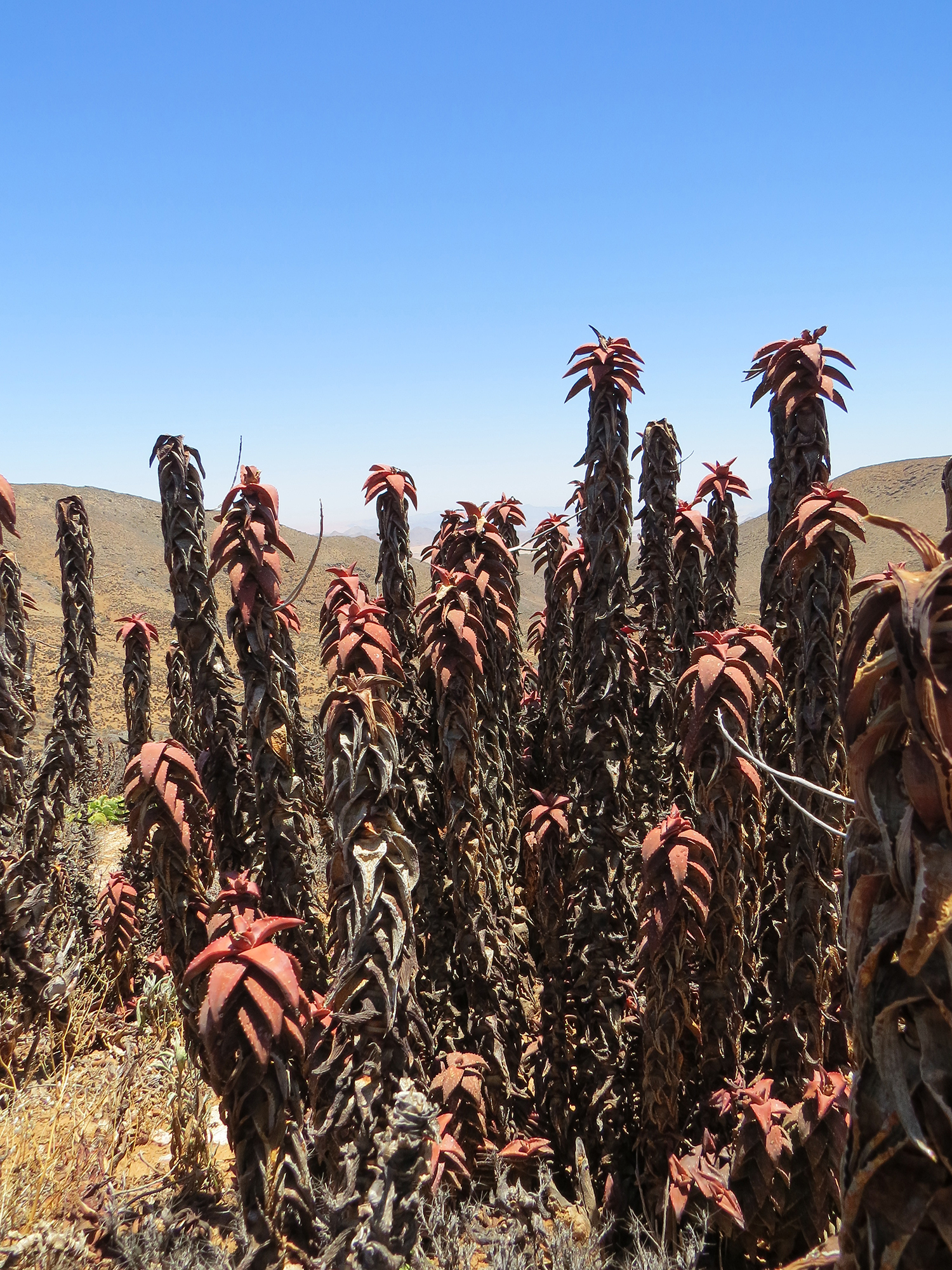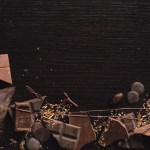OUR BURNING PLANET 168
A botanist watches evolution and extinction play out in Richtersveld

No one alive knows more about the specialised and diverse plants of the Richtersveld than ‘amateur’ botanist Pieter van Wyk, whose family have lived and farmed here since the 1830s. Yet he’s seeing entire species disappear – it appears that up to 85% of the populations of many plants have died. So what keeps him going?
First published in the Daily Maverick 168 weekly newspaper.
In January and February, the mountainsides of Helskloof usually blaze yellow-orange-red as thousands of Pearson’s Aloes flower. It’s an astonishing display of plant life in the desiccated expanses of the |Ai-|Ais/Richtersveld Transfrontier Park. But nowadays, all is not well.
The aloe occupies only about 52km² in the Richtersveld, and just over the Orange River in Namibia. Livestock feeds on it when under pressure; mining and drought are other threats. But some kind of tipping point has struck. In late November 2020, the park’s nursery curator, Pieter van Wyk, mapped out a 50m by 50m square transect in Helskloof, and counted the number of dead and living aloes within it. All too many had turned to lifeless, grey-brown husks. The characteristic reddish leaves atop the survivors, too, were unnervingly sparse, despite recent good rains. “None of them is healthy,” Van Wyk says. “This population is likely to [become] extinct.”
Average temperatures in the Richtersveld rose by a formidable 2.9°C between 2012 and 2019, and for much of this time the region was battered by drought. (The Paris Agreement committed countries to make changes to prevent global warming above 2°C.) Studies are under way, but anecdotally it appears that up to 85% of the populations of many plants – not just the unlucky Pearson’s Aloes – have died. Conditions have become too extreme, too quickly. Even the otherworldly floristic symbol of this area, the Pachypodium namaquanum, or halfmens, has been devastated: it’s not that easy to spot their strange, spiny bodies in Halfmens Pass any more. Skeletons of quiver trees dot Kokerboomkloof. Elsewhere, masses of the region’s vygies or Aizoaceae have died back, leaving soils vulnerable to erosion.
The Richtersveld, a mountainous desert, often appears barren to newcomers. Yet its flora is astonishing, wildly unique – and richer in species than any comparable arid area on Earth. A single 3km-long valley on the park’s tallest peak, Vandersterrberg, has a species count of 782: more than 10 of South Africa’s national parks. There are more than 40 species of carrion flowers and a vast variety of vygies. As much as 30% of the region’s flora is endemic. Species are finely attuned to the harsh conditions, sometimes to exceptional degrees.
As is Van Wyk. If this amateur botanist were a plant, he’d be a new species. Intense, hyperfocused and blessed with a brain to rival a supercomputer, Van Wyk, 32, is as much a product of his environment as the Richtersveld flora. His mother says he was made in Alexander Bay, at the mouth of the Orange River, and born in Port Nolloth, as there wasn’t a doctor in town back then. His Richtersveld roots run deep, as his family have lived and farmed here since the 1830s. “We were big hunters, and destructive,” he says. “My great-grandma’s brother shot the last hippo in 1925; another relative shot the last free-roaming cheetah in the 1960s.”

A species showing its incredible seed pods, which open once enough water falls on them, ejects seeds if conditions are right, or else close again to waits for another rainy day. (Photo: Janine Stephen)
But Van Wyk has been “insane” about plants and living things since he was a child. At 12, he was asking his family not to eat tortoise, a local Nama delicacy. By 14, he was writing a guide to the plants of the Richtersveld, a magnum opus that after innumerable edits is finally close to publication. He walks the desert for days on end in search of new species; his house is a herbarium containing 5,000 plant specimens. He is that rare thing: a person whose life is an endless quest in pursuit of why, and who has no doubts that it’s worth trying to find out.
Richtersveld living requires tenacity. I met Van Wyk in Sendelingsdrif Rest Camp, on the Orange River. Just outside camp, a mining vehicle was climbing a towering mine dump, a yellow ant on a blighted landscape. The afternoon winds stirred up an orange cloud of suspended grit: mining continues in some areas of the national park.
Inside camp, the rubbish of eras past has been disposed of and the Richtersveld Desert Botanical Garden is growing fast. Started in 2014, its plants have largely been rescued from the path of mining operations. The garden and nursery are a repository of beleaguered things – including Nama knowledge. In his typically frank but disarming manner, Van Wyk says he knows more about Nama names and uses for plants than anyone alive. “Oom Johannes Obies taught me,” he says. “He passed at 88.” Van Wyk learnt to read and understand Nama in Windhoek, in part so that he could include Nama plant names in his book.
Chance is a mysterious thing. “It’s a kind twist of fate that the powers that be put Pieter van Wyk – who is probably best described as a prodigy – in the Richtersveld,” ecologist Dr Philip Desmet later told me on the phone. “His knowledge and ability, across languages and botany, are exceptional. There are many deserts in the world, but the Richtersveld is top of the pile in terms of biodiversity; there’s no other place like it on Earth. It’s quite interesting that a person of his skill and intellect happened to arrive in the world’s most diverse arid biome. It’s fortunate for the place, his presence and discoveries.”
In one section of the nursery, succulents pepper various trays; small lumps and nodules, some resembling minerals more than flora. Some are more than 100 years old, despite their diminutive size. These, Van Wyk explains, are poached plants, rescued but now doomed to captivity. It’s an indication of how specialised Richtersveld plants can be.

View looking towards Namibia, Tatasberg, 04 Richtersveld NP. (Photo: Steve Newbould, Tourism Blueprint)
A growing black market
“There has been a boom in poaching, especially of succulent plants,” says Van Wyk, who asks us not to photograph the plants’ meticulous labels. “Probably, the [scale of the] trade is worth more than rhino horn. A species was poached to extinction in August [2020].” Syndicates feed the European and Asian markets, with social media driving demand. “Someone gave the name ‘Hot Lips’ to one of the succulents in the Succulent Karoo biome. People went crazy, everyone wanted one. By November 2019 more than a million people on eBay were asking for this species.”
Another victim is a Conophytum named the Cross of Christ. Only about 1,000 of the plants existed; three poaching incidents decimated the wild population. News reports over the past year hint at the scale of the illegal plant trade in the dry Northern Cape: South Koreans poached more than 60,000 Conophytums and were fined R5-million in February 2020 – the fourth conviction of plant poachers in five months. Men were found with 11,000 endangered plants in May 2020. Ten men were arrested in Upington in January 2021 with 8,000 succulents.
Even halfmens plants in the park itself have been poached, says Richtersveld Park manager Brent Whittington. “We were fortunate enough to intervene,” he says. “The entire industry has escalated considerably. We have been actively assisting the South African Police Service with numerous cases [in the region] and the numbers and values of plants are alarmingly high: tens of thousands of plants with a black-market value in the tens of millions of rand, and this only for plants within the Namaqua region.”

Dead and living Pearson’s Aloes in Helskloof. (Photo: Janine Stephen)
Replanting confiscated specimens is no simple matter. Here, plant populations have adapted to tiny changes in geology, altitude or location to gain an advantage and survive. Low-slung succulents must cope with extreme heat – ground temperatures of more than 80°C have been measured. In places, white quartz chips coat the earth and reflect the sun’s rays, making the soil just a few degrees cooler. As a result, they’re a haven for small succulent species adapted to such microclimates. “Every population is genetically different,” explains Van Wyk. Popping plants randomly back into similar habitats could “stuff up the whole species” by compromising the genetics that allow unique populations to survive.
Van Wyk has discovered 25 new plants in the Richtersveld alone, remarkable for an “amateur” botanist who has severe dyslexia and thus has never studied formally. In September last year he stumbled upon an Othonna some 3m high, from the same genus as the sunflower. “I realised I was probably the first person to ever see it and recognise it,” Van Wyk says. “I immediately walked around the mountain to see if there were more.” But the plant, the biggest new discovery in the Northern Cape in 30 years, appears to grow only on a single mountain slope.
Later, deep in the park, we visited a quiver tree, another species suspected to be dying in large numbers as the climate changes. As people took selfies in front of it, Van Wyk scoured the earth nearby. He was searching for a special small succulent, a population he knew well. After a few fruitless circles, he shrugged. There was not one specimen left in the stony ground.
Hardship shapes new life forms
How does a botanist or environmentalist deal with this kind of loss? The rapid destruction of poaching; the slow drip of climate change? It is hard to convey in print, but Van Wyk’s mind is a machine gun of activity, an arsenal of thoughts and theories. He doesn’t do half-hearted. At some point in the rich flow of information, he mentions a proposed industrial development near Alexander Bay that will threaten some exceptionally rare habitat. “I sat without sleeping for 65 hours when I found out about it,” he says. “It’s where I grew up.” Then he wrote a report to oppose it.
People are “the meteorite hitting the planet”, say Van Wyk. Yet since that dark sleepless period, he’s found a way to live with, if not accept, some of the threats climate change and humans bring. In part, it’s the result of studying the Richtersveld’s own ancient geology and cycles. The Namib desert is somewhere between 55 and 85 million years old; some of the mountains of the Richtersveld existed “four continents before Gondwana formed”. Once, this area was forest. “Extinction events have happened over and over,” Van Wyk says. Harsh conditions have not snuffed out life here: they drive evolution and have contributed to the high levels of endemism. He gestures to the landscape, a place that still bears traces of glaciers. “If you look at the diversity in a place like this, it’s because of hardship.
“If an elephant kills a species of plant, or a human kills a species of plant, or a meteor kills it, a volcano, a sunspot … it’s what happens. At the end of the day, if something goes extinct because of pressure there will be something in nature that finds a way to survive against that pressure.
“We place ourselves too high. Humans are part of nature. Nature doesn’t need to be conserved by humans – humans are part of nature.”

Gnarled succulent with the rather wicked common name of grandmother’s breasts. (Photo: Janine Stephen)
This strangely comforting long-term thinking is not an excuse for inaction. (“I won’t go and be destructive, because I’ve got a conscience and I’m still alive and, like any species, I need to consider how to stay alive. I’m not saying all of us must just gobble everything, and we can’t be hippies all of us. That would be a disaster if you want to buy bread!”) Biodiversity should be conserved where possible. But understanding evolution allows for glimmers of hope amid the tumult. As Van Wyk says, after the last mass extinction “things turned out really amazing – look at what we’re seeing around us now”.
Life finds a way, as a recent article in Scientific American explored. But don’t be tempted to think that mass extinctions simply open up space for more biodiversity. After the Ordovician-Silurian mass extinction, 440 million years ago, fossil data collected suggests “biodiversity did not rebound until more than 20 million years later”.
Quiver trees and other flora
On 19 February 2021, botanical experts will hold a Zoom workshop to assess whether the Pearson’s Aloe, as well as the quiver trees Aloidendron dichotomum, Aloidendron ramosissimum and Aloidendron pillansii, need to be notched up on the global Red Data List. Right now, the South African National Biodiversity Institute (Sanbi) Red List classifies the giant quiver tree as endangered, and the other three species as vulnerable. The aloe and Aloidendron dichotomum aren’t on the International Union for Conservation of Nature Red List, whereas the giant quiver tree, listed as critically endangered, was last assessed in 1998.

Pearson’s Aloes in Helskloof. Historically abundant, they are now dying in masses. (Photo: Janine Stephen)
Notes from previous Sanbi assessments lay bare the threats. Climate change models suggest Aloidendron dichotomum’s range will shrink by 36% in 100 years – presuming it migrates south by 2.5km per year, and uphill by 1.6m per year as conditions in other areas become more suitable. When last assessed, in December 2018, no colonisation of new areas had happened yet. Sanbi calls it a “vital flagship species for climate change impacts on biodiversity” and “likely to be a keystone and umbrella species”. What happens to the quiver tree, in other words, points to what’s happening to countless other species as their world heats up.
Keeping hope alive
Pearson’s Aloes take seven years to produce viable seed. Odds are the population in Helskloof won’t simply bounce back in our lifetimes. Yet on the drive back to the gate following the transect, Van Wyk seemed relaxed, speaking of Richtersveld marvels at every turn: the Numeesberg, a peak with more species per square kilometre than the Amazon; rediscovering the critically endangered Lachenalia nordenstamii; researchers studying bat language. (Males and females sound different.) He pointed out a dead shrub, saying even common species are becoming vulnerable to climate changes, “but don’t worry about it because it’s happened many times before”.
Pearson’s Aloe (Aloe pearsonii) probably once shared an ancestor with Aloe meyeri, which grows on steeper cliffs and in shade, where it’s cooler. Aloe pearsonii, on the other hand, developed to cope with the more exposed slopes. “Somewhere in the past, circumstances forced a species to develop two growth forms for two different habitats,” says Van Wyk. If Pearson’s Aloe does become extinct, Aloe meyeri should survive thanks to its microhabitat. If and when good conditions return, “the species can possibly adapt and migrate back into the open again”. And change doesn’t have to be slow. An alien tree, Prosopis glandulosa, finding itself being eaten by browsers in its new African home in Sendelingsdrif, developed spines within 100 years.
“Pearson’s Aloe will go extinct, or it might find a way to survive,” Van Wyk says. “Or conditions might change. I’m hoping for conditions to change. I want to see a green Richtersveld.” DM168
This story first appeared in our weekly Daily Maverick 168 newspaper which is available for free to Pick n Pay Smart Shoppers at these Pick n Pay stores.






















 Become an Insider
Become an Insider
Brilliantly insightful ! Just thinking …. maybe those we call ‘politicians’ (or most at least) evolved ‘spines’ (in more ways than one) as their ‘defense’ mechanism ? Come to think about it, most ‘lawyers’ too !